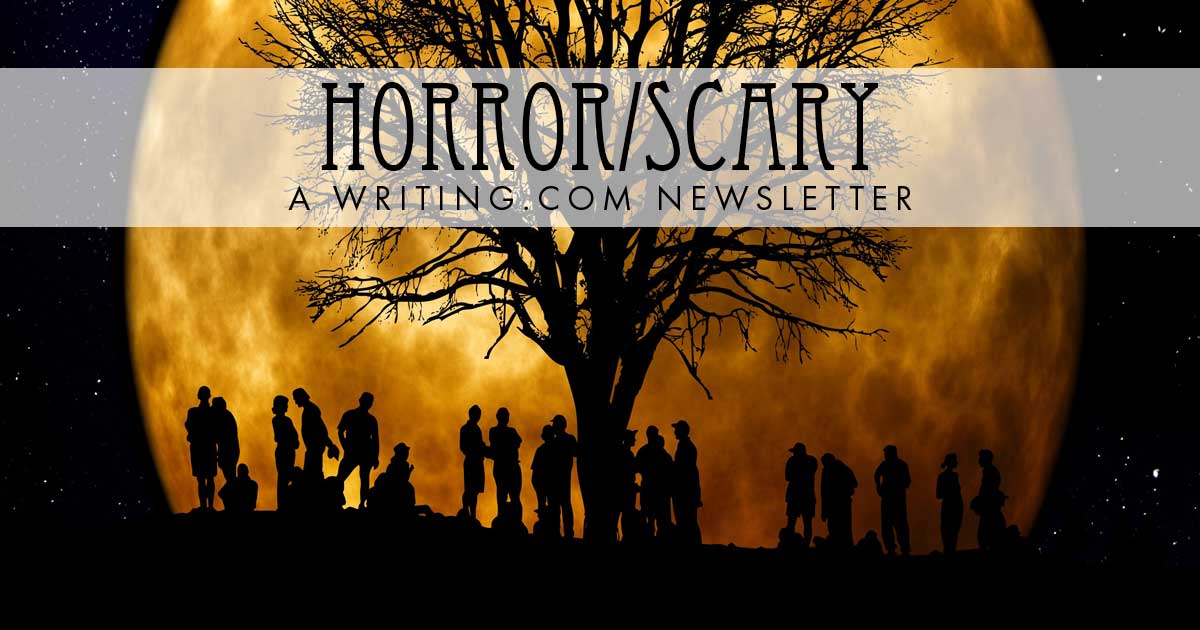This week: Writing Psychological Horror Edited by: Lilli ☕  
More Newsletters By This Editor 
![Table of Contents [#401437]
Table of Contents](https://shop.Writing.Com/main/trans.gif) ![Table of Contents [#401437]
Table of Contents Table of Contents](/main/images/action/display/ver/1709303267/item_id/401437.png)
1. About this Newsletter
2. A Word from our Sponsor
3. Letter from the Editor
4. Editor's Picks
5. A Word from Writing.Com
6. Ask & Answer
7. Removal instructions
![About This Newsletter [#401439]
About This Newsletter](https://shop.Writing.Com/main/trans.gif) ![About This Newsletter [#401439]
About This Newsletter About This Newsletter](https://www.writing.com/main/images/action/display/ver/1709303676/item_id/401439.png)
All those fears that dwell deep within us, the Horror genre exploits them and brings them forward; it scares you, thrills you, makes your heart race and your skin sheen over with cold sweat until you turn on the lights and leave those lights on as you fall asleep at night, because you are unsure if the bogeyman is hiding in your dark closet, or if there is the body of a drowned woman under your bed, ready to grab your bare ankle as you fall into a slumber.
|
![Letter from the editor [#401442]
Letter from the editor](https://shop.Writing.Com/main/trans.gif) ![Letter from the editor [#401442]
Letter from the editor Letter from the editor](https://www.writing.com/main/images/action/display/ver/1709303784/item_id/401442.png)
Psychological Horror, on the other hand, is a bit different. Psychological Horror asks you the question: What are you afraid of becoming?
Not who, but what you are afraid of being or becoming.
And sometimes, even more disturbingly, who are you, really, underneath your veneer?
Because Psychological Horror is all about the horrors that hide deep within your psyche. Psychological Horror asks you: if the world was engulfed in a strange mist full of monsters, and you and your son are seemingly the only two living beings on the planet, and you have a gun with only two bullets left, what would you do?
So, how do you write a Psychological Horror?
1. Defining elements of Psychological Horror
The most prevalent element in psychological horror stories is the unreliable narrator. As the story progresses, it is not only the protagonist’s life that’s on the line but their sanity as well.
The second element is atmosphere. A horror story may be fast-paced and full of jump scares. In psychological horror stories, however, the pace is slower, the horrors are results of various psychological fears.
The third element is artistic realism – or, bringing your story as close to reality as possible. In psychological horror, the protagonist is often a regular person, with a regular life, and a regular job, and often, even the villain – if there is a villain – is also human. There is little to no room in psychological horror for the supernatural.
2. Psychological fears
There are different types of fears. There are common fears like fear of spiders, fear of snakes, and other types of phobias. However, each one of your readers is unique, and their personal fears will differ from one another.
So, how to unnerve the readers in your story?
The first step consists of empathy and sympathy. I've mentioned before how the best psychological stories are rooted in reality rather than the supernatural world. When it comes to empathy, you need to give the readers a protagonist they can relate to: a mother who has recently lost a child or a husband or both, a father whose baby goes missing as he checks into a hotel, a weary traveler getting stranded in an isolated community and needs to get out of the rain, so he checks into an old inn.
There is only one fear that you need to tap into – the fear of not knowing what’s real and what isn’t, and the fear of losing a grip on reality. |
![Editor's Picks [#401445]
Editor's Picks](https://shop.Writing.Com/main/trans.gif) ![Editor's Picks [#401445]
Editor's Picks Editor's Picks](https://www.writing.com/main/images/action/display/ver/1709303830/item_id/401445.png)
| |  | Invalid Item 
This item number is not valid.
#2222317 by Not Available. |
|
![Word From Writing.Com [#401447]
Word from Writing.Com](https://shop.Writing.Com/main/trans.gif) ![Word From Writing.Com [#401447]
Word from Writing.Com Word from Writing.Com](https://www.writing.com/main/images/action/display/ver/1709303874/item_id/401447.png)
Have an opinion on what you've read here today? Then send the Editor feedback! Find an item that you think would be perfect for showcasing here? Submit it for consideration in the newsletter!
https://www.Writing.Com/go/nl_form
![Ask & Answer [#401448]
Ask & Answer](https://shop.Writing.Com/main/trans.gif) ![Ask & Answer [#401448]
Ask & Answer Ask & Answer](https://www.writing.com/main/images/action/display/ver/1709303902/item_id/401448.png)
![Unsubscribe [#401452]
Removal Instructions](https://shop.Writing.Com/main/trans.gif) ![Unsubscribe [#401452]
Removal Instructions Removal Instructions](https://www.writing.com/main/images/action/display/ver/1709303960/item_id/401452.png)
To stop receiving this newsletter, click here for your newsletter subscription list. Simply uncheck the box next to any newsletter(s) you wish to cancel and then click to "Submit Changes". You can edit your subscriptions at any time.
|
